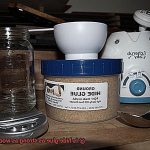Ready to dive into the world of sticky experimentation? Brace yourself as we explore the age-old question: Is it OK to put glue on your hands? From the daring and curious to the crafty and imaginative, this unconventional practice has piqued the interest of many.
So, let’s peel back the layers and uncover the pros, cons, and everything in between when it comes to using glue as a bonding agent for your skin.
Is it OK to put glue on your hands?
Contents
Pros of Using Glue on Your Hands:
- Get a Grip: Looking for that extra oomph when it comes to holding onto objects? Some claim that a thin layer of glue can provide an enhanced grip, perfect for activities like rock climbing or weightlifting. It’s like having an adhesive superhero sidekick right at your fingertips.
- Quick Fix: In a pinch without any bandages nearby? While not a substitute for proper medical care, some believe that using glue on minor cuts or scrapes can temporarily seal them off from further dirt or contamination. Just remember, this is a temporary solution until you can get proper medical attention.
- Artsy Adventures: Calling all crafters and artists. Embrace your inner Picasso with glue-on-hands creativity. This technique allows you to experiment with mesmerizing textures or create awe-inspiring designs that can be peeled off later. It’s like having your own personal art exhibit right on your palms.
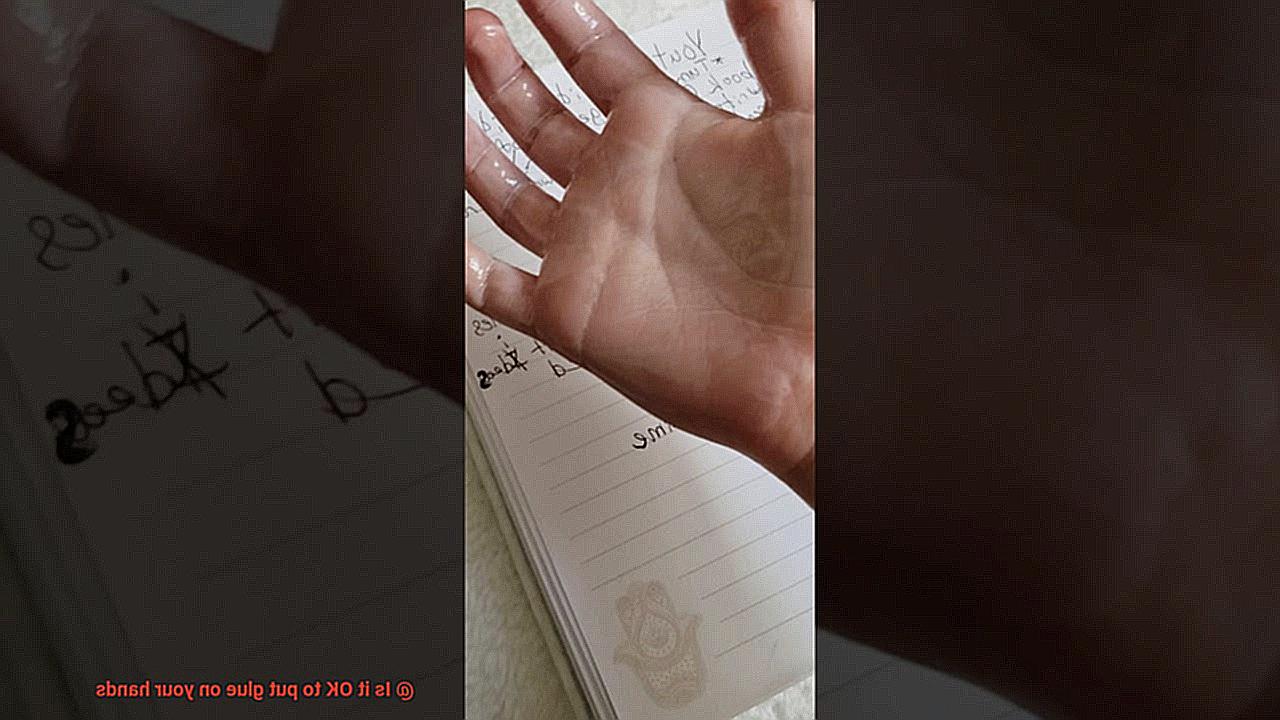
Cons and Risks of Using Glue on Your Hands:
- Skin Sensitivity SOS: Glue isn’t exactly formulated for direct skin contact, so don’t be surprised if you encounter some redness, irritation, or even allergic reactions. The severity can vary depending on factors like your skin type, sensitivity levels, and the type of glue used. Proceed with caution.
- Health Hazards Ahead: Long-term use or frequent exposure to glue on your hands could potentially lead to the absorption of harmful chemicals into your system. It’s crucial to understand the composition of the glue and the potential long-term consequences before diving headfirst into this sticky adventure.
- Glue Removal Woes: Brace yourself for a battle when it comes time to bid adieu to that sticky situation on your hands. Aggressive scrubbing or harsh chemicals can damage your skin, leaving you feeling like you’re stuck in a never-ending cycle of adhesive frustration.
Types of Glue
While it may seem like harmless fun, it’s important to consider the potential risks and precautions before diving into this sticky situation. In this blog post, we will explore different types of glue and their safety when it comes to hands-on activities. So, let’s get our hands dirty and find out if it’s safe to put glue on your hands.
Types of Glue:
- School Glue: This glue is a staple in every classroom, perfect for arts and crafts projects. However, when it comes to putting it directly on your hands, it may not be the best idea. School glue can make a sticky mess and has a tendency to peel off easily from the skin, resulting in disappointment rather than a satisfying sensory experience.
- Super Glue: With its quick bonding power, super glue is renowned for its strength. However, this adhesive is not recommended for direct contact with your hands. Super glue can cause irritation and may even bond your skin together, turning a playful experiment into a potentially painful predicament.
- Wood Glue: If you’re working on a woodworking project, wood glue is your go-to adhesive. While it’s generally safe for external use on skin, applying it directly to your hands can be messy and cumbersome to remove. Plus, who wants sticky wood residue clinging onto their fingers?
- Epoxy: Epoxy adhesives are super strong and versatile, making them perfect for bonding metals, ceramics, and glass. However, they should be kept far away from your hands. Applying epoxy directly to your skin can lead to irritation and potentially bond your skin together like an unwanted handshake.
- Fabric Glue: This specialized adhesive is designed for bonding fabrics like cotton and denim. It’s generally safe for external use on skin, but be cautious if you have sensitive skin. Fabric glue may cause irritation or a rash in some individuals, turning your hands from soft and supple to itchy and uncomfortable.
Precautions:
Before you embark on a sticky adventure, it’s crucial to take some precautions to ensure your safety and well-being. Here are a few tips to keep in mind:
- Read the instructions: Glue products come with instructions for a reason. Always take the time to read and follow them carefully before using any adhesive.
- Use gloves or protective barriers: If you decide to put glue on your hands, consider using gloves or creating a protective barrier with plastic wrap. This extra layer of protection can help minimize direct contact between the glue and your skin.
- Wash your hands: After indulging in a sticky playtime, make sure to wash your hands thoroughly with soap and water. This will remove any residue and help prevent potential skin irritation or discomfort.
Harmful Chemicals in Glue
Glue is a common household item that serves various purposes, from arts and crafts to repairing broken objects. However, it’s important to be aware of the potential risks associated with its use, specifically the presence of harmful chemicals.
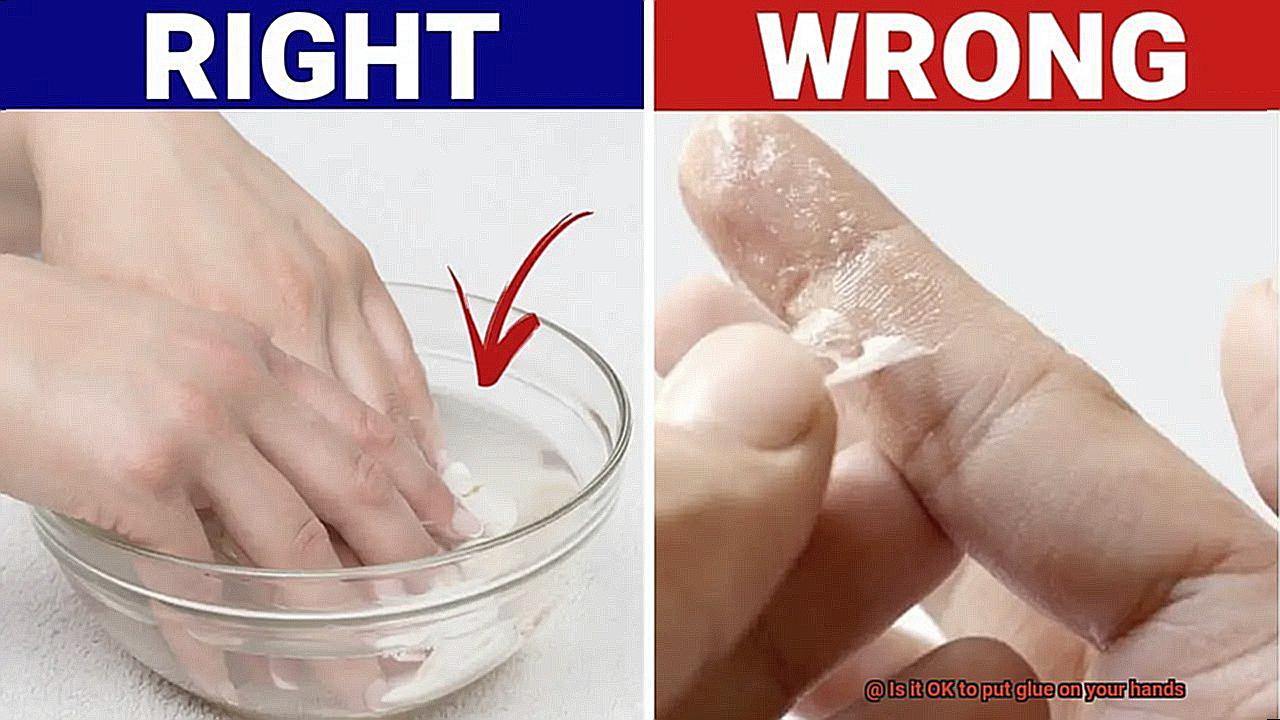
One of the main culprits in glue is formaldehyde. This colorless gas, often found in certain types of glue, can cause serious skin irritation, including redness, itching, and allergic reactions. Prolonged exposure to formaldehyde can even lead to respiratory issues and cancer. It’s definitely not the kind of adhesive bond we’re looking for.
Another chemical commonly found in glue is toluene. This solvent helps glue dry faster but is classified as a volatile organic compound (VOC). Inhaling or being exposed to toluene can make you as dizzy as a spinning top and cause nausea. It can also damage your central nervous system. Talk about a sticky situation.
But wait, there’s more. Some glues contain other toxic chemicals like acetone, xylene, and benzene. These chemicals can irritate your skin, mess with your respiratory system, and even lead to long-term health issues if used regularly or in large amounts. That’s definitely not the kind of adhesive relationship we want to have.
However, not all glues are created equal. Some glues are labeled as non-toxic or safe for skin contact. These glorious creations are usually water-based and free from harmful substances. So make sure to read those labels and opt for safer alternatives whenever possible.
But hey, even with safer glues, it’s important to take precautions. Slap on those protective gloves, work in a well-ventilated area, and keep that glue far away from your precious skin. And if by chance you do end up in a sticky situation, wash it off with soap and water faster than you can say “Oops.”
Skin Sensitivity to Glue
Glue, the unsung hero of countless tasks, can sometimes leave behind an unexpected mark. Skin sensitivity to glue is a perplexing phenomenon that affects certain individuals, causing allergic reactions. In this enlightening article, we will delve into the deep recesses of this enigma, exploring its causes, symptoms, and the proactive measures one can take to prevent it.
Causes:
- Chemical Composition: The potent chemical composition of certain glues, like super glue or epoxy adhesive, increases the likelihood of skin sensitivity.
- Prolonged Exposure: Lingering contact with glue on the skin heightens the risk of developing sensitivity reactions.
- Repeated Use: Frequent exposure to glue without proper protection gradually sensitizes the skin, making it more susceptible to adverse reactions.
- Pre-existing Skin Conditions: Individuals with pre-existing skin conditions, such as eczema or dermatitis, are particularly prone to experiencing skin sensitivity when exposed to glue.
Symptoms:
- Redness: The affected area may flush with a fiery hue, signaling the body’s inflammatory response.
- Itching: A relentless itchiness plagues those with glue-induced skin sensitivity.
- Swelling: The surrounding skin may puff up like an inflated balloon, a visible testament to the body’s defense mechanisms.
- Rash: A rash adorned with tiny bumps or blisters may emerge, leaving a trail of irritation.
Preventative Measures:
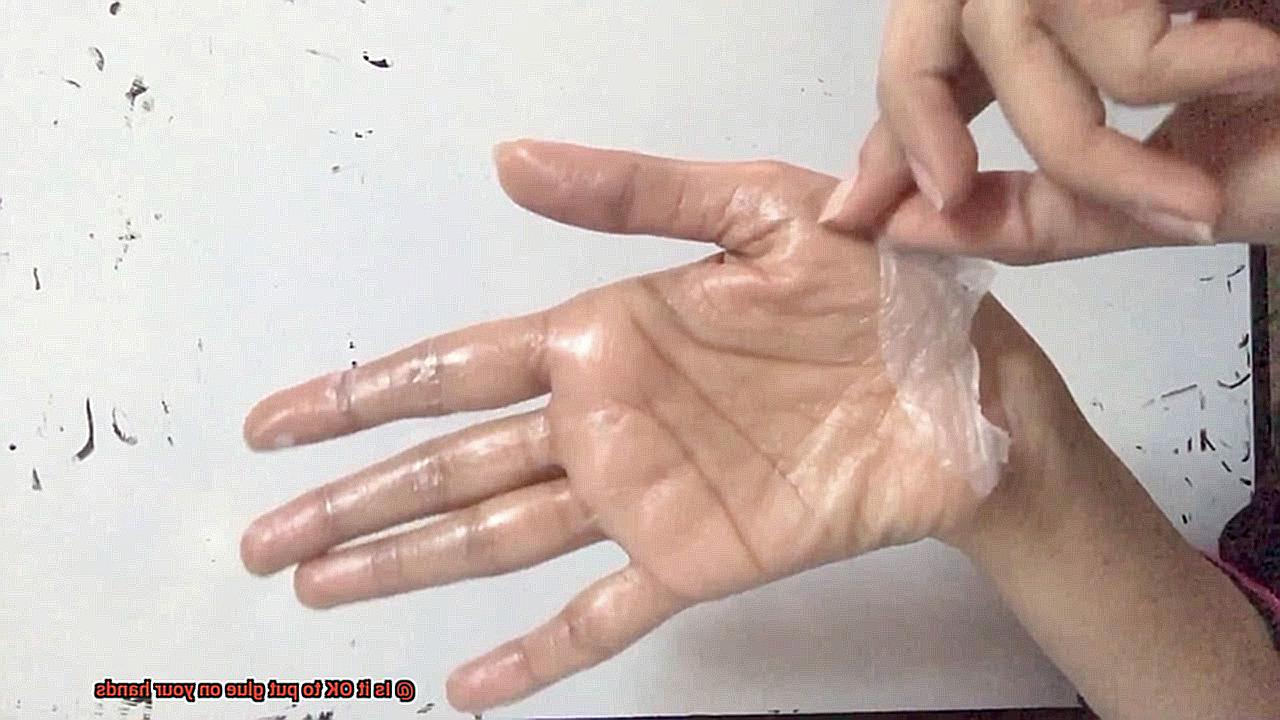
- Protective Barriers: Shield your delicate skin by donning gloves or using protective barriers when handling adhesive substances.
- Patch Testing: Before applying a new type of glue on larger areas of your skin, perform a patch test by applying a small amount to monitor for any adverse reactions.
- Personal History Check: Be vigilant about your personal history of allergic reactions or sensitivities before exposing your skin to glue.
- Immediate Action: Should discomfort or signs of a reaction arise after glue contact, wash the affected area immediately with soothing soap and water.
- Symptom Relief: Seek solace in mild hydrocortisone cream or an antihistamine to alleviate the tormenting symptoms.
- Seek Medical Attention: In severe cases where the reaction persists or worsens, it is prudent to seek the guidance of medical professionals.
Potential Risks of Putting Glue on Hands
Glue is a versatile adhesive that helps us tackle a variety of tasks, from DIY projects to arts and crafts. However, it’s important to be aware that putting glue on your hands can pose potential risks to your skin and overall health. In this article, we’ll delve into the sticky world of glue and explore the potential dangers you should know about.
Skin Irritation and Burns:
One of the primary concerns when using glue on your hands is its strong adhesive properties. Glue can stick to your skin and be challenging to remove, leading to skin irritation, redness, and in some cases, even burns. The effects can be exacerbated by using strong glues or prolonged exposure.
Toxic Chemicals:
Certain types of glue contain harmful chemicals such as formaldehyde, toluene, and acetone. These substances can be absorbed through the skin and enter your bloodstream, potentially causing toxic effects on your body. It is crucial to read labels and choose glues that are free from these harmful chemicals to protect your health.
Accidental Ingestion:
Accidentally ingesting glue or mistaking it for food can be dangerous, especially for children. Glues that contain toxic substances can cause nausea, vomiting, and even organ damage in severe cases. To prevent accidents, keep glues out of reach of children and ensure proper storage.
Allergic Reactions:
Some individuals may develop an allergic reaction to certain components of glue. Symptoms can range from mild itching and redness to more severe reactions like hives, swelling, or difficulty breathing. If you experience any of these symptoms after using glue, seek immediate medical attention.
Eye Irritation:
Accidental contact with glue in the eyes can cause irritation, redness, and potentially damage the cornea. If this happens, rinse the affected eye with water immediately and seek medical assistance, if needed. Prompt action can help prevent serious eye injuries.
Unsafe Behaviors:
Putting glue on your hands may lead to unsafe behaviors, such as peeling off dried glue. This can result in skin tearing or abrasions, which may lead to infection or further complications. Avoid engaging in such risky activities to protect your skin and overall well-being.
Precautions When Putting Glue on Hands
While it may seem harmless, putting glue on your hands can pose risks to your skin and health. However, fear not. By taking a few simple precautions, you can ensure a safe and hassle-free glue experience.
Choose the right glue:
When embarking on a gluey endeavor, opt for glues specifically designed for skin contact. Look for labels that proudly proclaim their non-toxicity and safety for use on skin. Regular glue or adhesive products may contain harmful chemicals that could lead to skin irritation or allergic reactions.
Clean your hands:
Before delving into the glue adventure, ensure that your hands are thoroughly clean. Use soap and water to remove any dirt or oils from your skin. This will provide a clean canvas for the glue to adhere to, allowing for better performance.
Protective gear:
For those with sensitive skin or a tendency towards allergies, consider donning gloves or other protective gear. This acts as a barrier between the glue and your skin, minimizing the risk of adverse reactions and ensuring a smoother experience.
Apply a small amount:
Less is more when it comes to applying glue on your hands. Use only a small amount and spread it evenly on the desired area. Avoid slathering on a thick layer, as this can lead to excessive drying and cracking—definitely not the outcome you’re aiming for.
Avoid contact with sensitive areas:
Exercise caution and keep the glue away from sensitive areas such as your eyes, mouth, open wounds, or cuts. In case of accidental contact, rinse the affected area with water immediately and seek medical attention if necessary.
Keep still while drying:
As the glue begins its journey towards solidification, keep your hands still. Avoid touching other surfaces or objects, lest the glue ends up adhering to unwanted areas. Remember, patience is key.
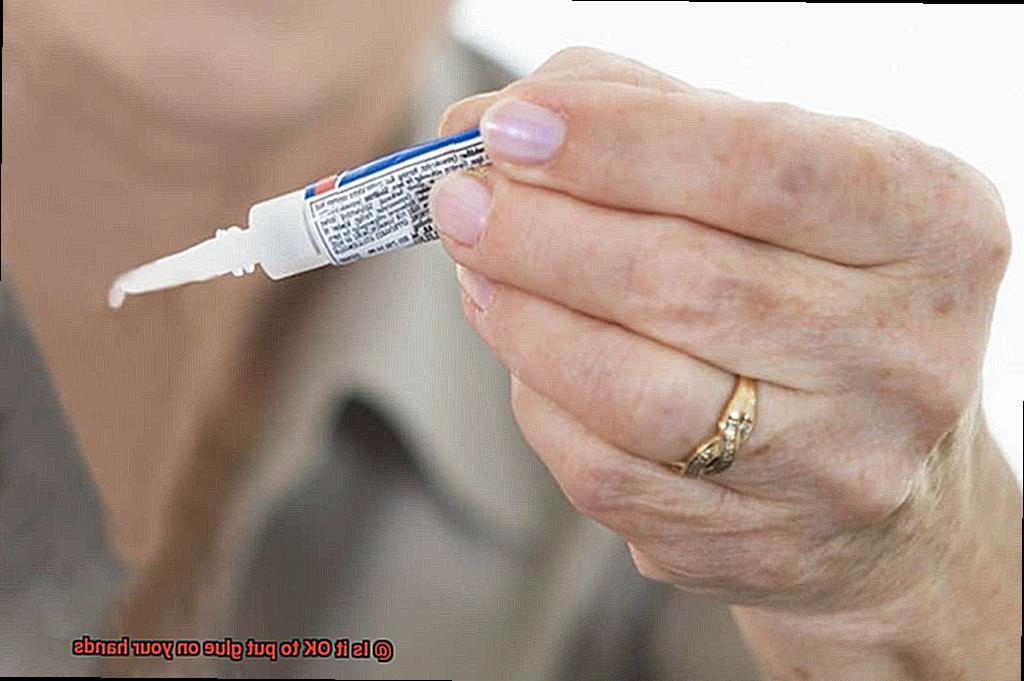
Follow recommended drying time:

Resist the temptation to rush the drying process. It’s crucial to follow the recommended drying time mentioned on the glue packaging. Removing the glue before it has fully dried may result in poor adhesion or leave sticky residue on your hands.
Gentle removal:
Once the glue has achieved its dry and solid state, it’s time for a graceful exit. Gently peel it off your skin, avoiding any forceful pulling or tearing. Such aggressive maneuvers can cause skin damage or irritation. If removal proves challenging, consider using an adhesive remover or seeking professional assistance.
Clean and moisturize:

After bidding farewell to the glue, cleanse your hands once again with soap and water to ensure all remnants are banished. To restore hydration and soothe your skin, apply a moisturizer or lotion. After all, glues can sometimes leave your skin feeling parched.
Safety Guidelines for Children
Glue can be an extraordinary tool for nurturing your little one’s creativity, but it’s vital to establish some safety guidelines to keep their hands happy and healthy. So, let’s dive right in.
- Choose the right glue: Not all glues are created equal. Look for non-toxic, water-based glues specifically designed for children. These options ensure that your child won’t be exposed to any harmful ingredients or strong fumes.
- Keep an eye on them: Supervision is key. Watch over your young ones while they’re using glue to prevent accidents and step in if anything goes awry. Make sure they use the glue properly and avoid applying it directly onto their skin (ouch.).
- Educate and empower: Teach your kids about the potential dangers of putting glue on their hands. Explain that certain glues can cause skin irritation or even chemical burns if left on for too long. Encourage them to use glue only as intended for their art projects.
- Wash those hands: Hand hygiene is a must. Before applying the glue, have your child wash their hands thoroughly with soap and water to remove any dirt or oils that could interfere with the adhesive properties. And once they’ve finished their masterpiece or completed using glue altogether, remind them to wash their hands again to remove any residue.
- Stay calm in sticky situations: Accidents happen, right? If your child accidentally gets glue on their hands, don’t panic. Most non-toxic glues can be easily washed off with soap and water. However, if it’s particularly sticky or stubborn, seek guidance from a healthcare professional or call a poison control center for advice.
- Gear up for protection: Let’s gear up. Encourage your little artists to wear protective gear like disposable gloves or aprons while using glue. This minimizes direct contact between the adhesive and their skin, reducing the risk of any potential adverse reactions. Plus, it keeps their clothes clean and prevents stains (a win-win.).
- Store it safely: Last but not least, store those glue containers securely out of reach. Accidental ingestion of glue can be hazardous, especially if it contains toxic ingredients. Keep them in a designated area where your little ones can’t access them without adult supervision.
Alternative Options to Enjoy the Sensation of Glue
Fear not. In this article, we will take you on a sensory adventure, introducing you to enchanting alternatives that let you indulge in the tactile experience without actually using glue on your hands. So, let’s dive in and discover these fascinating substitutes.
Slime and Putty:
If you crave the squishy and stretchy texture of glue, slime and putty are perfect alternatives for you. These sensory toys come in a mesmerizing array of colors, scents, and textures that allow you to customize your sensory experience. Squish, mold, and pull to your heart’s content, all while keeping your hands clean and glue-free.
Sticky Tack or Adhesive Putty:
Looking for that sticky sensation without the mess? Sticky tack is here to save the day. This reusable adhesive offers a delightfully malleable texture that can be rolled, twisted, and pressed between your fingers. Perfect for fidgeting or satisfying that craving for something sticky.
Modeling Clay or Playdough:
If shaping and molding bring you joy with glue, modeling clay or playdough will surely delight you. These materials provide a similar tactile experience while offering endless possibilities for creative expression. Plus, they come in different vibrant colors and can even be scented for an added sensory boost.
Sensory Bins and Tactile Sensory Activities:
For a truly immersive tactile experience, nothing beats sensory bins. Fill a container with rice, beans, sand, or beads – the choice is yours. Run your hands through these materials, bury objects within them, or simply revel in the delightful textures against your skin. It’s like diving into a treasure chest of sensory wonders.
Fidget Toys:
When you’re on the go and need a quick sensory fix, fidget toys are your best friends. Stress balls, textured sensory balls, or any small handheld object that offers different textures and sensations when squeezed or manipulated can provide the perfect substitute for glue. Feel the satisfying squish, squeeze, or roll as you indulge in these tactile wonders.
fGL8ct5z84s” >
Conclusion
Putting glue on your hands may seem like a harmless experiment, but it’s important to consider the potential risks involved.
Additionally, glue can be difficult to remove from the skin and may cause damage if not properly cleaned off.



